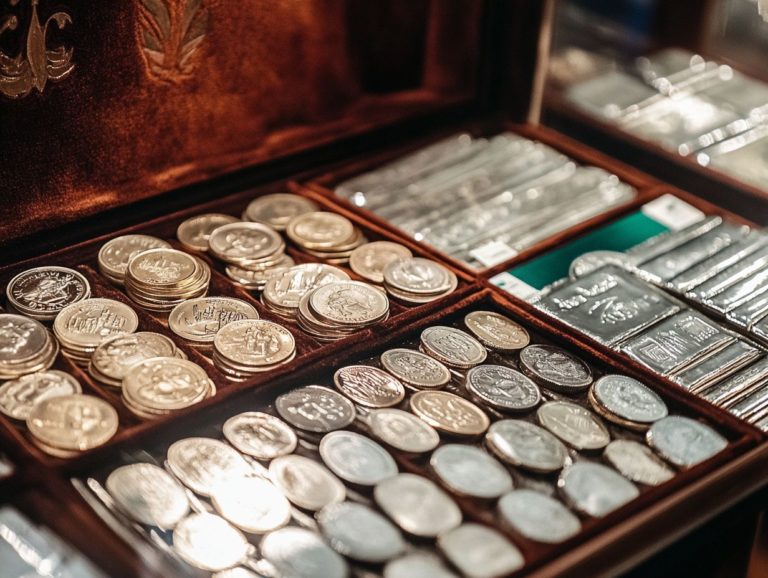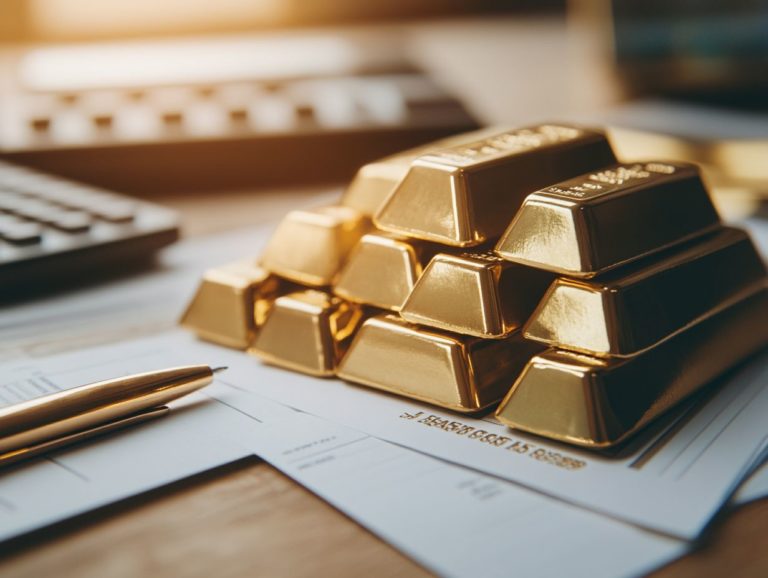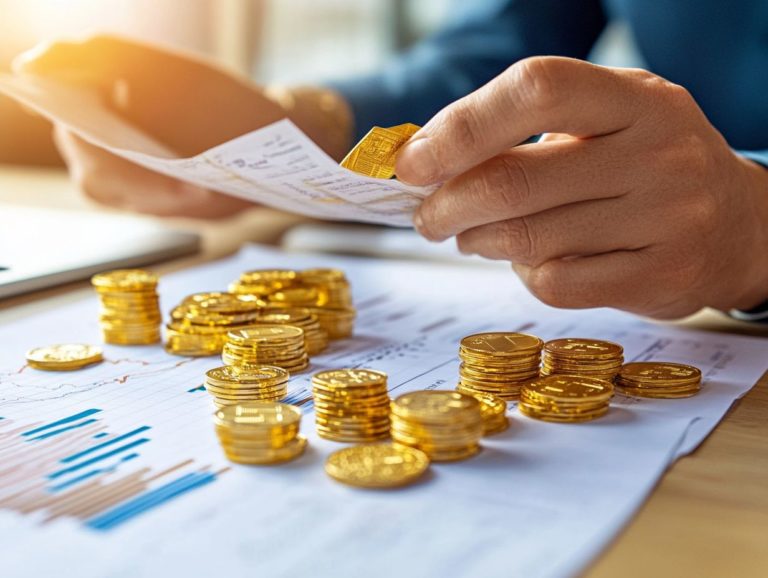The Future of Precious Metals Taxation: Trends to Watch
Precious metals have always been a highly sought-after asset. They serve as a reliable hedge against inflation and a trusted store of value.
Taxation can be overwhelming for investors. This article simplifies precious metals taxation for you, illuminating existing laws and emerging trends that could significantly impact your investments.
It also offers predictions for the future, along with practical strategies designed to help you maximize tax benefits while minimizing burdens. Whether you re a seasoned investor or just starting your journey, understanding these dynamics is essential for making informed decisions.
Contents
- Key Takeaways:
- The Current State of Precious Metals Taxation
- Trends in Precious Metals Taxation
- Predictions for the Future
- Strategies for Navigating Precious Metals Taxation
- Frequently Asked Questions
- What are some current trends in precious metals taxation?
- How might global demand for precious metals impact taxation in the future?
- What are some potential changes in tax laws and regulations that could impact precious metals taxation?
- How might fluctuating prices of precious metals affect taxation?
- What are some potential consequences of high taxes on precious metals?
- How can individuals and businesses stay informed about changes in precious metals taxation?
Key Takeaways:
- Changes in taxation policies can greatly impact the precious metals industry and investors. Stay informed and adapt to these changes to minimize potential tax burdens.
- Be strategic in navigating precious metals taxation by maximizing tax benefits and minimizing your tax load. Seek expert insights and forecasts to make informed decisions.
- The future of precious metals taxation is uncertain. Experts predict potential shifts in tax laws and regulations. Stay alert! These trends can significantly affect your investments.
What are Precious Metals?
Precious metals, such as gold, silver, and the platinum group metals, are rare, naturally occurring elements that carry substantial economic weight. Throughout history, they ve been used as currency, investment options, and commodities.
Gold prices fluctuate frequently, influenced by market trends, economic indicators, and geopolitical tensions. This makes these metals vital players in the global economy.
Gold has long been known as a reliable store of value. It finds its place in everything from exquisite jewelry to the manufacturing of electronics. It also serves as a hedge against inflation and currency fluctuations, offering you a sense of security in uncertain times.
Silver, often referred to as the poor man’s gold, is used for both investment and various industrial applications. The platinum group metals, including platinum and palladium, are crucial for catalytic converters and other industrial technologies.
Historically, these assets have shown remarkable resilience, weathering economic storms and proving their worth during financial uncertainty. You may find yourself drawn to these precious metals during market volatility, viewing them as a safe haven.
This creates a fascinating cycle between their demand and economic stability, highlighting their enduring value in your investment strategy.
The Current State of Precious Metals Taxation
The current landscape of precious metals taxation is shaped by many factors. Federal regulations, investment behaviors, and market conditions all play crucial roles, especially concerning the activities of the Federal Reserve and the broader dynamics of the global economy.
Existing Tax Laws and Regulations
Existing tax laws and regulations surrounding precious metals dictate how you must report your transactions. This can significantly impact your overall investments and strategies.
According to the IRS, precious metals like gold, silver, platinum, and palladium are classified as collectibles, which subjects them to a maximum capital gains tax rate of 28%.
This classification might prompt you to reevaluate your approach to these investments, potentially nudging you toward alternative assets or a mix of different investments to mitigate those tax implications. Additionally, understanding silver market trends can also play a crucial role in your investment strategy.
As retail demand ebbs and flows with market trends and compliance costs, you may find yourself balancing the allure of immediate returns against the promise of long-term growth. The intersection of taxation and investment strategies not only influences your purchasing decisions but also adds layers of complexity to market volatility.
Shifts in retail sentiment can drive prices up or down, making this dance of investments all the more intriguing.
Trends in Precious Metals Taxation
Trends in precious metals taxation are evolving, adapting to the dynamic landscape shaped by changing economic conditions and shifting investment behaviors.
As awareness of market trends grows, these changes are influenced by a myriad of geopolitical tensions and monetary policies.
Changes in Taxation Policies
Recent changes in taxation policies regarding precious metals indicate a broader shift in economic strategy. This shift is influenced by factors such as the Federal Reserve s monetary policy and rising inflation the rise in prices over time.
You may notice that tax rates on profits from selling precious metals have increased, leading you to reassess your portfolio. During times of economic uncertainty, many individuals gravitate toward tangible assets like precious metals, viewing them as a safe haven. However, with the new tax implications, the allure of investment becomes less clear. To better understand these changes, it’s important to explore the future of precious metals, as this could alter your investment behavior.
Analysts warn that this complex interplay between tax policies and market sentiment could introduce increased volatility. As you weigh the tangible benefits of ownership against the backdrop of higher costs, exploring the latest trends in precious metal storage may fundamentally reshape your market perspective.
Impact on Investors and the Industry
The impact of taxation on you as an investor in precious metals is profound. It influences both your retail demand and the overall dynamics of the industry, especially during periods of fluctuating gold prices and economic shifts.
This influence extends beyond your individual buying decisions. It shapes the entire marketplace and guides supply chain strategies. You often find yourself weighing the tax implications of your transactions, which can dictate your willingness to engage in the market during periods of volatility. Understanding the 5 types of precious metals investments can also help inform your decisions in such conditions.
Since taxes can significantly alter your net returns on investments, they play a crucial role in determining the capital flowing into precious metals. Varying fiscal policies can influence your sentiment and lead to changes in your purchasing behavior. Ultimately, these factors impact the delicate balance between supply and demand. In an uncertain environment, they create waves that ripple through the industry, especially regarding the future of precious metals.
Predictions for the Future
Predictions for the future of precious metals indicate a landscape shaped by a multitude of economic indicators, evolving investment behaviors, and the enduring impacts of geopolitical tensions, especially concerning influential nations like Russia and China.
Expert Insights and Forecasts
Expert insights and forecasts regarding precious metals suggest that your investment decisions will increasingly be influenced by demand trends driven by inflation, market volatility, and the broader global economic landscape.
As you navigate these turbulent waters, pay attention to the rise of sustainable mining technologies. These technologies are becoming essential in shaping investment strategies. For insights on how to stay ahead of precious metals trends, companies that embrace environmentally friendly practices not only reduce their ecological footprint but also position themselves advantageously in a market that prioritizes sustainability.
This shift is likely to attract a new wave of socially conscious investors like you, who value environmental stewardship as much as traditional financial metrics. Consequently, the implications for your investment strategies could be significant. You may find yourself seeking out firms that integrate these technologies into their operations, potentially transforming the industry’s landscape for years to come.
Navigating the intricacies of precious metals taxation is essential for you as an investor aiming to optimize your holdings. In a landscape shaped by fluctuating gold prices and evolving market trends, employing effective strategies can make a substantial difference in your financial outcomes.
Understanding these tax changes can help you make smarter financial choices. Stay informed about these changes to protect your investments.
Maximizing Tax Benefits
Maximizing tax benefits when investing in precious metals requires a keen understanding of existing laws and innovative investment vehicles designed to navigate the complexities of taxation.
Closely monitor how monetary policies, like changes in interest rates and inflation control measures, can create favorable conditions for your investment choices. By employing strategies such as utilizing special accounts that help you save on taxes like IRAs specifically tailored for precious metals, you can effectively shield your gains from unnecessary tax burdens. Additionally, staying informed about the trends shaping the future of precious metals can enhance your investment strategy.
Understanding market dynamics helps you select the right timing for purchases and highlights potential capital gains exemptions, enhancing your overall returns. Stay informed about legislative shifts to make proactive adjustments to your portfolio and keep an eye on gold investment trends to stay ahead in the game!
Minimizing Tax Burden
Minimizing the tax burden associated with your precious metals investments requires thoughtful planning and a keen awareness of IRS regulations regarding transaction reporting.
Explore effective strategies to manage your tax liabilities. Consider tactics like tax-loss harvesting; this means selling off investments that have lost value to offset gains on which you have to pay tax, taking advantage of tax-advantaged accounts, or seeking opportunities for long-term capital gains benefits. Additionally, stay informed about the future of gold as current market trends and economic indicators can provide valuable insights into the best timing for your transactions.
Understanding the fluctuations in gold prices or shifts in the silver market enables you to make informed decisions that align with your financial goals while ensuring compliance with relevant tax laws.
Frequently Asked Questions
What are some current trends in precious metals taxation?
Current trends in precious metals taxation show exciting shifts, such as increased global demand for precious metals, fluctuating prices, and changes in tax laws and regulations.
How might global demand for precious metals impact taxation in the future?
The increasing demand for precious metals, particularly in emerging economies, may lead governments to impose higher taxes on the production and sale of these metals to generate more revenue.
What are some potential changes in tax laws and regulations that could impact precious metals taxation?
Governments may implement new tax policies, such as a windfall profits tax, or increase existing taxes on the production and sale of precious metals to fund budget deficits or address environmental concerns related to mining.
How might fluctuating prices of precious metals affect taxation?
Fluctuating prices can make it difficult for governments to accurately assess the value of precious metals and determine appropriate tax rates. This can result in frequent changes in tax laws and regulations, creating uncertainty for investors and businesses.
What are some potential consequences of high taxes on precious metals?
High taxes can discourage investment in the mining and production of precious metals, resulting in reduced supply and higher prices for consumers. It may also lead to an increase in illegal mining and black market sales.
How can individuals and businesses stay informed about changes in precious metals taxation?
Individuals and businesses can stay informed by regularly monitoring news and updates from government agencies and tax authorities. Follow industry news and consult tax experts regularly to stay updated!















